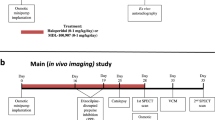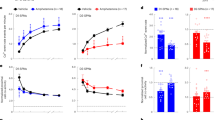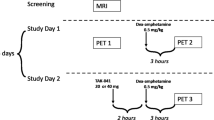Abstract
Measuring the in vivo occupancy of antipsychotic drugs at dopamine D2 and D3 receptors separately has been difficult because of the lack of selective radiotracers. The recently developed [11C]-(+)-PHNO is D3-preferring, allowing estimates of the relative D2 and D3 binding of antipsychotic drugs. We used positron emission tomography (PET) imaging in baboons with [11C]-(+)-PHNO to examine the binding of clozapine and haloperidol to D2 and D3 receptors. Four animals were scanned with dynamically acquired PET and arterial plasma input functions. Test and retest scans were acquired in single scanning sessions for three subjects to assess the reproducibility of [11C]-(+)-PHNO scans. Four additional scans were acquired in each of three subjects following single doses of antipsychotic drugs (clozapine 0.5534 mg/kg, haloperidol 0.0109 mg/kg, two administrations per drug per subject) and compared with baseline scans. The percent change in binding (ΔBPND) following challenges with antipsychotic drugs was measured. A regression model, based on published values of regional D2 and D3 fractions of [11C]-(+)-PHNO BPND in six brain regions, was used to infer occupancy at D2 and D3 receptors. BPND following antipsychotic challenge decreased in all regions. Estimated D2 : D3 selectivity was 2.38 for haloperidol and 5.25 for clozapine, similar to published in vitro values for haloperidol (3.03), but slightly higher for clozapine (2.82). These data suggest that acute doses of clozapine and haloperidol bind to D3 receptors in vivo, and that the lack of D3 occupancy by antipsychotics observed in some recent imaging studies may be because of other phenomena.
Similar content being viewed by others
Log in or create a free account to read this content
Gain free access to this article, as well as selected content from this journal and more on nature.com
or
References
Abi-Dargham A, Martinez D, Mawlawi O, Simpson N, Hwang DR, Slifstein M et al (2000). Measurement of striatal and extrastriatal dopamine D-1 receptor binding potential with [C-11]NNC 112 in humans: validation and reproducibility. J Cerebr Blood F Met 20: 225–243.
Beaver JD, Gallezot JD, Nabulsi N, Weinzimmer D, Singhal T, Slifstein M et al (2009). PHNO in vivo affinity for D2 and D3 receptors: a PET study in rhesus monkeys. J Cerebr Blood F Met 29: S59–S62.
Cheng YF, Lundberg T, Bondesson U, Lindstrom L, Gabrielsson J (1988). Clinical pharmacokinetics of clozapine in chronic schizophrenic patients. Eur J Clin Pharmacol 34: 445–449.
Creese I, Burt DR, Snyder SH (1976). Dopamine receptor binding predicts clinical and pharmacological potencies of antischizophrenic drugs. Science 192: 481–483.
Ekelund J, Slifstein M, Narendran R, Guillin O, Belani H, Guo NN et al (2007). In vivo DA D-1 receptor selectivity of NNC 112 and SCH 23390. Mol Imaging and Biol 9: 117–125.
Endres CJ, Carson RE (1998). Assessment of dynamic neurotransmitter changes with bolus or infusion delivery of neuroreceptor ligands. J Cereb Blood Flow Metab 18: 1196–1210.
Friston KJ, Holmes AP, Worsley KJ, Poline J-P, Frith CD, Frakowiak RSJ (1995). Statistical parametric maps in functional imaging: a general linear approach. Hum Brain Mapping 2: 189–210.
Graff-Guerrero A, Mamo D, Shammi CM, Mizrahi R, Marcon H, Barsoum P et al (2009). The effect of antipsychotics on the high-affinity state of D2 and D3 receptors: a positron emission tomography study With [11C]-(+)-PHNO. Arch Gen Psychiatry 66: 606–615.
Innis RB, Cunningham VJ, Delforge J, Fujita M, Giedde A, Gunn RN et al (2007). Consensus nomenclature for in vivo imaging of reversibly binding radioligands. J Cerebr Blood F Met 27: 1533–1539.
Kapur S, Seeman P (2000). Antipsychotic agents differ in how fast they come off the dopamine D2 receptors. Implications for atypcial antipsychotic action. J Psychiatry Neurosci 25: 161–166.
Kegeles LS, Slifstein M, Frankle WG, Xu X, Hackett E, Bae SA et al (2008). Dose-occupancy study of striatal and extrastriatal dopamine D2 receptors by aripiprazole in schizophrenia with PET and [18F]fallypride. Neuropsychopharmacology 33: 3111–3125.
Kudo S, Ishizaki T (1999). Pharmacokinetics of haloperidol. Clin Pharmacokin 37: 435–456.
Lammertsma AA, Hume SP (1996). Simplified reference tissue model for PET receptor studies. Neuroimage 4 (3 Part 1): 153–158.
Levant B (1997). The D3 dopamine receptor: neurobiology and potential clinical relevance. Pharmacol Rev 49: 231–252.
McCormick PN, Kapur S, Graff-Guerrero A, Raymond R, Nobrega JN, Wilson AA (2010). The antipsychotics olanzapine, risperidone, clozapine, and haloperidol are D2-selective ex vivo but not in vitro. Neuropsychopharmacology 35: 1826–1835.
Narendran R, Slifstein M, Guillin O, Hwang Y, Hwang DR, Scher E et al (2006). Dopamine (D2/ 3) receptor agonist positron emission tomography radiotracer [11C]-(+)-PHNO is a D3 receptor preferring agonist in vivo. Synapse 60: 485–495.
Rabiner EA, Slifstein M, Nobrega J, Plisson C, Huiban M, Raymond R et al (2009). In vivo quantification of regional dopamine-D3 receptor binding potential of (+)-PHNO: studies in non-human primates and transgenic mice. Synapse 63: 782–793.
Schotte A, Janssen PF, Gommeren W, Luyten WH, Van Gompel P, Lesage AS et al (1996). Risperidone compared with new and reference antipsychotic drugs: in vitro and in vivo receptor binding. Psychopharmacology (Berl) 124: 57–73.
Searle G, Beaver JD, Comley RA, Bani M, Tziortzi A, Slifstein M et al (2010). Imaging dopamine D(3) receptors in the human brain with positron emission tomography, [(11)C]PHNO, and a selective D(3) receptor antagonist. Biol Psychiatry 68: 392–399.
Seeman P (2002). Atypical antipsychotics: mechanism of action. Can J Psychiatry 47: 27–38.
Seeman P, Lee T (1975). Antipsychotic drugs: direct correlation between clinical potency and presynaptic action on dopamine neurons. Science 188: 1217–1219.
Slifstein M, Parsey R, Laruelle M (2000). Derivation of [11C]WAY-100635 binding parameters with reference tissue models: effect of violations of model assumptions. Nucl Med Bio 27: 487–492.
Sokoloff P, Diaz J, Le Foll B, Guillin O, Leriche L, Bezard E et al (2006). The dopamine D3 receptor: a therapeutic target for the treatment of neuropsychiatric disorders. CNS Neurol Disord Drug Targets 5: 25–43.
Tsukada H, Miyasato K, Kakiuchi T, Nishiyama S, Harada N, Domino EF (2002). Comparative effects of methamphetamine and nicotine on the striatal [C-11]raclopride binding in unanesthetized monkeys. Synapse 45: 207–212.
Wilson AA, McCormick P, Kapur S, Willeit M, Garcia A, Hussey D et al (2005). Radiosynthesis and evaluation of [11C]-(+)-4-propyl-3,4,4a,5,6,10b-hexahydro-2H-naphtho[1,2-b][1,4]oxazin-9 -ol as a potential radiotracer for in vivo imaging of the dopamine D2 high-affinity state with positron emission tomography. J Med Chem 48: 4153–4160.
Acknowledgements
This study was funded by the Lieber Center for Schizophrenia Research and partly by GlaxoSmithKline. The authors gratefully acknowledge the expert technical contributions of Elizabeth Hackett, John Castrillon and Sung A Bae.
Author information
Authors and Affiliations
Corresponding author
Ethics declarations
Competing interests
RRG has received research support from Janssen and Lilly through APIRE and a travel stipend from Lilly, Forest, and Elsevier Science through the Society of Biological Psychiatry. RNG and EAR are employees of GlaxoSmithKline. In the last 3 years, AA has received honoraria from BMS-Otsuka, Boehringer-Ingelheim, Lundbeck, and Sanofi-Aventis, as well as research support from GlaxoSmithKline. In the last 3 years, MS has served as a consultant for Amgen, and GlaxoSmithKline, and has received research support from Intracellular Therapies, XX, NM, and BE have no conflicts of interest to disclose.
Rights and permissions
About this article
Cite this article
Girgis, R., Xu, X., Miyake, N. et al. In Vivo Binding of Antipsychotics to D3 and D2 Receptors: A PET Study in Baboons with [11C]-(+)-PHNO. Neuropsychopharmacol 36, 887–895 (2011). https://doi.org/10.1038/npp.2010.228
Received:
Revised:
Accepted:
Published:
Issue date:
DOI: https://doi.org/10.1038/npp.2010.228
Keywords
This article is cited by
-
Imaging synaptic dopamine availability in individuals at clinical high-risk for psychosis: a [11C]-(+)-PHNO PET with methylphenidate challenge study
Molecular Psychiatry (2021)
-
A positron emission tomography occupancy study of brexpiprazole at dopamine D2 and D3 and serotonin 5-HT1A and 5-HT2A receptors, and serotonin reuptake transporters in subjects with schizophrenia
Neuropsychopharmacology (2020)
-
Occupancy of Dopamine D3 and D2 Receptors by Buspirone: A [11C]-(+)-PHNO PET Study in Humans
Neuropsychopharmacology (2016)
-
Preferential binding to dopamine D3 over D2 receptors by cariprazine in patients with schizophrenia using PET with the D3/D2 receptor ligand [11C]-(+)-PHNO
Psychopharmacology (2016)
-
Lack of Age-Dependent Decrease in Dopamine D3 Receptor Availability: A [11C]-(+)-PHNO and [11C]-Raclopride Positron Emission Tomography Study
Journal of Cerebral Blood Flow & Metabolism (2015)



